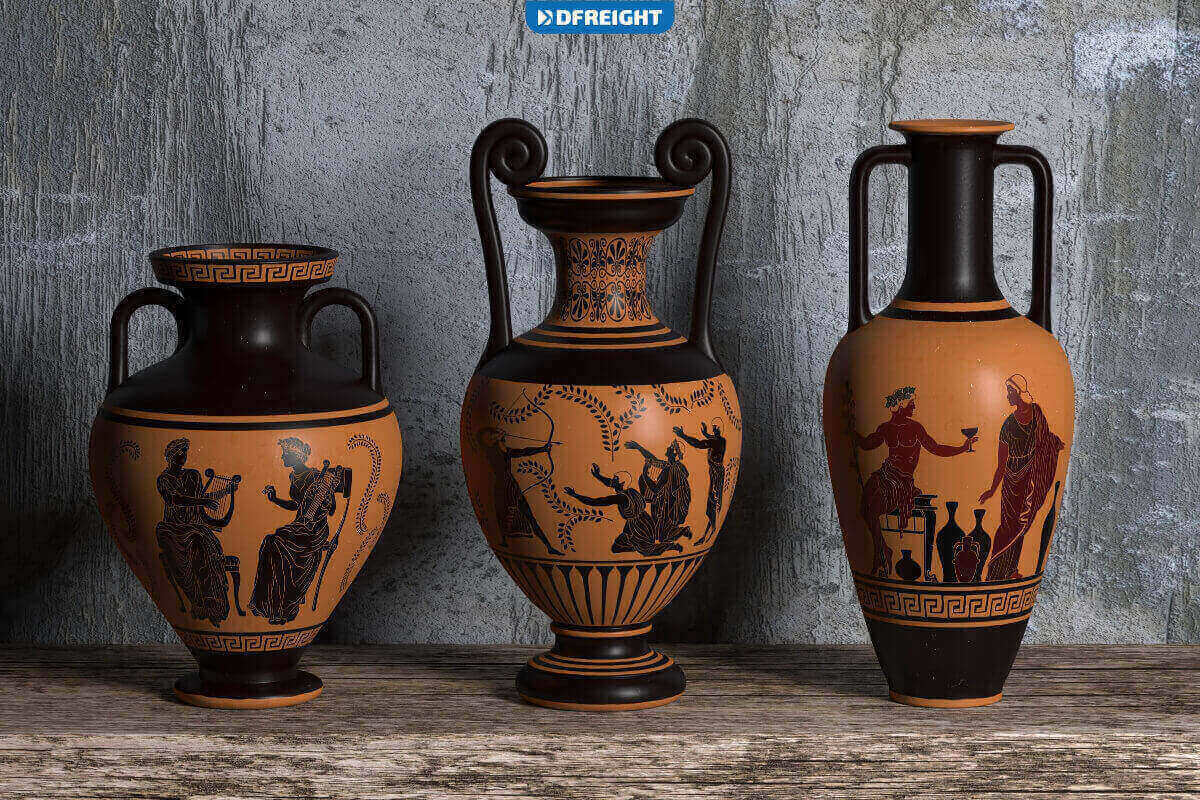Antiques hold a timeless allure, connecting us to the rich tapestry of human history and culture. Whether it’s a delicate vase passed down through generations, an intricately carved wooden cabinet, or a rare piece of art, each antique carries a story that transcends time. Preserving and protecting these cherished heirlooms is paramount, especially when shipping them to new destinations. Shipping Antiques can be daunting, with numerous potential hazards threatening the safety of these delicate and valuable items. Cracks, scratches, and breakages are among the top concerns that keep antique enthusiasts awake at night when preparing to send their treasured possessions across distances, whether for relocation, sale, or display in a new setting.
If you are ready to ship your valuable antiques confidently, Look no further than DFreight, the leading digital freight forwarder with an innovative online platform and user-friendly mobile app. With a brilliant record of shipping antiques, DFreight offers unmatched expertise in handling delicate and valuable items. Trust us to safeguard your treasures during transit and provide a seamless shipping experience. Experience peace of mind and choose DFreight for safely and efficiently shipping your cherished antiques. Get started today, and let us care for your most valuable possessions.
In this comprehensive guide, we delve into the world of shipping antiques, equipping you with the knowledge and expertise needed to navigate the journey of your precious pieces confidently. From choosing the suitable shipping method and proper packaging techniques to understanding legalities and dealing with customs, we leave no stone unturned in ensuring your antiques arrive at their destination unscathed.
Table of Contents
Preparing Antiques for Shipping
Shipping antiques requires meticulous preparation to ensure their safe journey to their destination. Taking the time to properly assess, pack, and secure your valuable items will significantly reduce the risk of damage during transit. Here are essential steps to prepare your antiques for shipping:
- Assessing the Condition of Your Antiques: Before packing, carefully examine each antique to identify any existing damage or vulnerable areas. Note any pre-existing cracks, chips, or weak points to address them during packing. Taking photos from multiple angles can also serve as documentation for insurance purposes.
- Proper Packaging Materials: Invest in high-quality packaging materials to protect your antiques. Use sturdy cardboard boxes, bubble wrap, packing peanuts, foam, and corrugated sheets to cushion the items. Avoid using old or worn-out boxes, as they may compromise the safety of your antiques.
- Disassembling and Securing Fragile Parts: For larger antiques, consider disassembling them to reduce the risk of damage during transit. Wrap and pack individual components separately, labeling them for easy reassembly. Secure any fragile parts, such as handles or delicate decorations, with bubble wrap or foam padding.
- Reinforcing and Padding: Properly padding your antiques is crucial to prevent movement inside the packaging. Use ample padding material to fill empty spaces, ensuring a snug fit. This will minimize the risk of impact or collision during shipping antiques.
- Custom Crating for Extra Protection: For exceptionally delicate or valuable antiques, consider investing in custom wooden crates. These crates provide an additional layer of protection and are tailor-made to fit your specific item, minimizing the chance of damage.
- Labeling and Fragile Marking: Clearly label each package with the contents and destination address. Use bold and visible “fragile” markings on all sides to alert handlers to exercise extra caution while handling the shipment.
- Documentation: Create an itemized list of all the shipped antiques, including their descriptions, dimensions, and value. This documentation will prove invaluable in case of an insurance claim or customs inspection.
- Insurance Considerations: Insuring your antiques during shipping is a wise investment. Check with your shipping provider or obtain a separate insurance policy to cover the full value of your items. Familiarize yourself with the terms and coverage limits to ensure adequate protection.
- Seal and Reinforce Packages: Once everything is packed, securely tape and seal all packages to prevent accidental openings. Reinforce corners and edges to withstand the handling stress they might encounter during transit.
By meticulously preparing your antiques for shipping, you can rest assured that they are well-equipped to withstand transportation challenges. Remember, the extra effort to protect your valued possessions will ensure their continued beauty and significance for years.
Choosing the Right Shipping Method
Selecting the appropriate shipping method is crucial to ensure your valuable antiques’ safe and timely delivery. The choice will depend on the antique’s size, weight, destination, budget, and required delivery speed. Here are some common shipping methods to consider:
- Professional Shipping Services: Opting for professional antique shipping services is often the safest choice. These specialized carriers have experience in handling delicate and valuable items. They offer customized packing, handling, and transportation solutions, reducing the risk of damage during transit.
- Ocean Freight: Ocean shipping is suitable for larger, heavier antiques and bulk shipments. It involves using shipping containers or pallets for shipping antiques. Freight carriers have the necessary equipment to handle substantial loads securely.
- Air Freight: When speed is of the essence, air freight can be an ideal option. It offers faster delivery times, making it suitable for time-sensitive antiques. However, it can be more expensive than other methods.
- Land Freight: Land freight is a cost-effective and commonly used method for domestic shipments. It is suitable for antiques that don’t have strict time constraints and can handle a slightly longer transit time.
- White Glove Service: White glove service is a premium shipping option where the carrier takes exceptional care of your antiques from start to finish. This includes packing, loading, unloading, and setting up the items at the destination.
- DIY Shipping: If you decide to handle the shipping, research and gather all necessary packing materials and follow proper packing techniques. DIY shipping is more suitable for smaller and less valuable antiques.
- Container Shipping: For international shipments, container shipping is an excellent choice. Your antiques will be placed in a sealed container, protecting them from the elements and potential damage during overseas transport.
- Expedited Shipping: When you need your antiques to reach their destination quickly, consider choosing the expedited shipping options many carriers offer. While more expensive, this method ensures a faster delivery time.
- Consolidated Shipping: If you are shipping multiple antiques to the same destination, consolidated shipping allows you to combine items into one shipment, reducing costs and the chance of misplacement.
Always inquire about the shipping provider’s experience handling antiques, read customer reviews, and request carrier quotes to compare pricing and services. By carefully selecting the suitable shipping method, you can rest assured that your precious antiques will arrive at their destination safely and sound, ready to be cherished and admired again.
Packing Techniques for Various Antiques
Proper packing is essential when shipping antiques to protect these valuable and delicate items during transit. Each antique requires specific packing techniques to ensure its safety. Here are packing guidelines for various kinds of antiques:

Furniture and Large Items:
- Remove any detachable parts such as legs, handles, or glass panels. Wrap them individually and secure them inside the main packaging.
- Cover the entire piece with furniture blankets or moving pads to protect against scratches and dents.
- Wrap the furniture in multiple layers of bubble wrap and add foam padding to vulnerable areas.
- Place cardboard corner protectors to shield the edges from impact.
Delicate Glassware and Ceramics:
- Each glass or ceramic piece should be individually wrapped with bubble wrap.
- Use packing peanuts or crumpled paper to fill any gaps in the box to prevent movement.
- Place the individually wrapped items in a sturdy box and then put that box inside another box with additional padding in between.
Artwork and Paintings:
- Ensure that all materials in contact with the artwork are acid-free to avoid potential damage over time.
- Place a layer of glassine or acid-free paper over the artwork’s surface to prevent sticking if there’s glass involved.
- Add a layer of rigid cardboard or foam board on both sides of the artwork to protect it from bending or flexing.
Collectibles and Small Items:
- Place small antiques inside individual boxes, ensuring a snug fit.
- Wrap each item with bubble wrap and use tape to secure it.
- Place the individually wrapped items in a larger box with cushioning material.
Fragile Antiques:
- For extremely fragile antiques, consider custom wooden crates that provide superior protection.
- If custom crating is not feasible, use double boxing with plenty of cushioning material between the inner and outer boxes.
Textiles and Fabrics:
- Wrap textiles in acid-free tissue paper to protect delicate fabrics.
- For tapestries and rugs, roll them and secure with acid-free tissue paper before placing them in a tube or box.
Electronics and Mechanical Antiques:
- If the antique contains batteries, remove them to avoid potential leaks during transit.
- Use foam or bubble wrap to secure any moving parts to prevent damage.
Always use high-quality packing materials like bubble wrap, packing peanuts, foam, and sturdy cardboard boxes. Label all packages clearly with contents and fragile markings. Additionally, consider insuring your antiques to provide financial protection in case of any unfortunate incidents during shipping. By employing appropriate packing techniques, you can safeguard your cherished antiques throughout their journey to their new destination.
Documentation and Legalities
Proper documentation and adherence to legal requirements are essential when shipping antiques to ensure a smooth and lawful transportation process. Please comply with these regulations to avoid delays, fines, or even confiscation of your valuable items. Here are essential documentation and legal aspects to consider:
- Researching Import/Export Regulations: Before shipping antiques internationally, thoroughly research the import and export regulations of the destination country and any transit countries. Each country has specific rules and restrictions concerning the transportation of certain antiques, such as cultural artifacts or endangered species materials.
- Required Documentation for International Shipping:
- Bill of Lading
- Commercial Invoice
- Certificate of Authenticity
- Export/Import Permits
- Customs Forms
- Prohibited and Restricted Items: Be aware of items that are prohibited or restricted from being shipped. These may include certain animal products, endangered species, ivory, cultural artifacts, etc. Ensure your antiques do not violate any international or local laws.
- Declaring the Correct Value: Be honest and accurate when declaring the value of your antiques. Underdeclaring or misrepresenting the value may lead to complications during customs inspections and insurance claims.
- Handling Taxes and Duties: Anticipate and prepare for potential import duties, taxes, and customs fees imposed by the destination country. These costs are typically the recipient’s responsibility, but it’s crucial to communicate and clarify this with them beforehand.
- Antique Origin and Provenance: Document the origin and provenance of your antiques to establish their historical significance and authenticity. This information can be vital in resolving disputes or inquiries during shipping.
- Insurance Coverage: Secure adequate insurance coverage for your antiques during shipping. This will offer financial protection in case of loss, damage, or theft during transit.
Remember that the specific documentation requirements and legal considerations may vary depending on the countries involved, the type of antiques, and their value. It’s advisable to consult with experienced antique shipping professionals or customs authorities to ensure compliance with all relevant laws and regulations. By following these guidelines, you can navigate the documentation and legalities of shipping antiques with confidence and peace of mind.
Labeling and Marking Packages
Labeling and marking packages correctly is a crucial step in ensuring antiques’ safe and efficient shipping. Clear and accurate labeling helps carriers identify the contents of each package and handle them with the appropriate care. When shipping antiques, it is essential to prominently label all packages as “fragile” to alert handlers to exercise caution during transit. Additionally, include the destination address, contact information, and specific handling instructions to avoid potential mishaps. By meticulously labeling and marking packages, you enhance the chances of your valuable antiques reaching their destination unharmed, allowing them to continue captivating others with their timeless beauty and historical significance.
Why DFreight is the Trusted Choice for Shipping Antiques
When entrusting your valuable antiques to a shipping company, choosing a reputable and experienced partner is paramount. DFreight stands out as an exceptional choice in the industry. As a leading digital freight forwarder, DFreight offers a seamless and innovative online platform and mobile app that simplifies shipping. With a wealth of experience handling delicate and valuable items like antiques, DFreight ensures that your precious belongings receive the utmost care and attention.
Our team of experts is well-versed in packing, handling, and shipping antiques, making them a trusted ally in preserving the integrity of your treasured pieces. By selecting DFreight, you can have confidence that your antiques will be in safe hands throughout their journey, arriving at their destination on time and in pristine condition.

International Shipping Tips
When shipping antiques internationally, following some key tips is essential to ensure a smooth and successful transportation process. First, research and understand the destination country’s import/export regulations and customs requirements to avoid any legal issues. Choose a reputable international shipping company with experience handling delicate and valuable items like antiques.
Properly package and protect your antiques using high-quality materials to withstand long journeys and potential handling hazards. Always declare the correct value of your antiques for customs purposes and consider obtaining insurance coverage to protect against unforeseen events. Communication with the shipping company and the recipient throughout the process is crucial to promptly address any concerns or requirements.
By following these international shipping tips, you can confidently ship your antiques across borders, knowing they will arrive safely at their destination and continue to enchant others with their timeless allure.
Conclusion
In conclusion, shipping antiques requires careful planning, attention to detail, and adherence to best practices. Preserving these cherished items’ beauty and historical significance during transit is paramount. From proper packaging techniques to selecting reputable shipping companies like DFreight, we have explored essential steps to ensure a smooth and safe journey for your valuable antiques. You can confidently transport your treasured possessions by taking the necessary precautions, understanding legalities, and being well-informed about international shipping.
Whether you are a collector, seller, or buyer, this comprehensive guide empowers you to navigate the complexities of shipping antiques easily. May your antiques inspire and connect future generations to the timeless legacy of human history and culture.
Are there any specific regulations for shipping antiques internationally?
Yes, shipping antiques internationally involves complying with specific import/export regulations of both the destination country and any transit countries. Research the requirements related to cultural artifacts, endangered species materials, and other restricted items. Obtain any necessary permits or licenses, and ensure your antiques do not violate any international or local laws.
What are the best packing materials for shipping antique decoratives?
When shipping antique decoratives, opt for high-quality packing materials such as butbble wrap, foam, packing peanuts, and sturdy cardboard boxes. Use acid-free tissue paper to protect delicate surfaces and prevent potential damage. For extra protection, consider custom wooden crates or double boxing to ensure the items arrive safely at their destination.
What should I do if my antique arrives damaged after shipping?
In the unfortunate event that your antique arrives damaged, take immediate action. Document the damage with photographs and retain all packaging materials as evidence. Contact your shipping company to report the damage and initiate an insurance claim, providing all necessary documentation. Keep communication open and follow the claim process diligently to ensure proper compensation for the damage.













